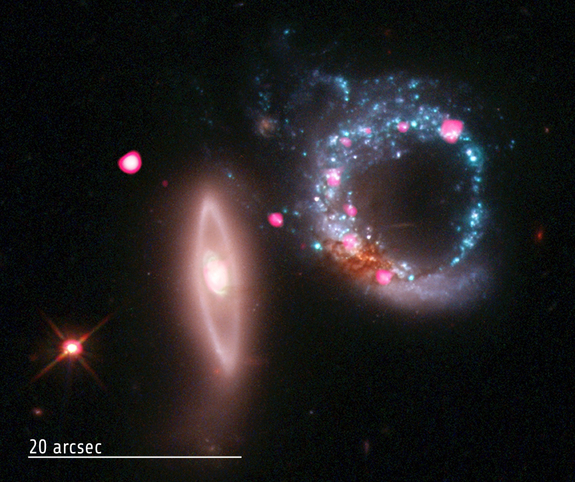Little help
-
 by
murrayles
by
murrayles
So for the nebula on the right side, how do you classify it. It is really irregular, it is not a bubble, no roundness, just a hot cloud full of new stars.
Posted
-
A recent Asttonomy Picture of the Day showed a runaway star, with the nebular region ahead of its motion deflected into a parabola from the shockwave. I suggest the star/object in the notch of this distorted bubble may be such a runaway star or at least a star in motion toward what was a Hubble bubble. The notch is close to parabolic, and the space around the bubble and star are otherwise not too gassy or dusty, so it may be that only the bubble shows the bow wave.
I'm not sure how we get the professionals to look at this one, but I'll try.
Posted
-
 by
ttfnrob
admin, scientist
in response to KhalilaRedBird's comment.
by
ttfnrob
admin, scientist
in response to KhalilaRedBird's comment.
KhalilaRedBird
A recent Asttonomy Picture of the Day showed a runaway star, with the nebular region ahead of its motion deflected into a parabola from the shockwave. I suggest the star/object in the notch of this distorted bubble may be such a runaway star or at least a star in motion toward what was a Hubble bubble. The notch is close to parabolic, and the space around the bubble and star are otherwise not too gassy or dusty, so it may be that only the bubble shows the bow wave.
I'm not sure how we get the professionals to look at this one, but I'll try.Hi there - I shall have a look and see what can be found out about this object.
Posted
-
 by
ttfnrob
admin, scientist
by
ttfnrob
admin, scientist
For a more zoomed-out view, see AMW00014bh
Posted
-
 by
ttfnrob
admin, scientist
in response to KhalilaRedBird's comment.
by
ttfnrob
admin, scientist
in response to KhalilaRedBird's comment.
This object generated a fair bit of talk around the science team. The consensus is that this is not a runaway star but most likely a massive, young protostar that has formed in the compressed region between two large bubbles.
If you look at the same object on a larger angular scale (AMW00014bh) you can see that this large, red blob sits between two large HII regions (bubbles). It is most like that this massive, young star is blowing out radiation and disturbing the nebula that helped create it.
Its interesting that you should recall that runaway stars though - I was thinking about these today as well. In fact I was wondering if they can be easily seen on the MWP. Although this time it seems not to be the case, they may still be out there.
Thanks for bringing an interesting object to our attention.Posted
-
by chairstar
********

This image of the two galaxies that form Arp 147 shows a vast cosmic ring of stars (blue) and black holes (pink) as seen by the Chandra X-ray Observatory and Hubble Space Telescope. Another galaxy is also visible (vertical at left), as well as a bright star and quasar (pink object at upper left). This image was released on Feb. 9, 2011. From Space.com -"Cosmic Valentines Day photo reveals black hole ring".
NASA/CXC/MIT/S.Rappaport et al, Optical: NASA/STScII assume the quasar they are refering to is the white spot with the reddish tinge around it. Is this is correct? I've seen plenty of these objects in the MWP photos. Could allowing a marker specifically for quasars be possible here in MWP? Would black holes appear as the pink objects referred to here - in your photos?
Also - I could use some better examples of GALAXIES, QUASARS and DARK NEBULAS as they appear in your photos.
Thanks GZU,
chairstar
Posted
-
 by
ttfnrob
admin, scientist
in response to chairstar's comment.
by
ttfnrob
admin, scientist
in response to chairstar's comment.
The MWP will not show you any quasars like this. The objects you see in the MWP are mostly within our own galaxy (there are a few exception, like the odd galaxy that may be peeking through the dust). In astronomy we have to use the same colours for all sorts of data. The Milky Way Project uses red. green and blue as described in this thread: http://talk.milkywayproject.org/science/discussions/DMW10009jb, which is different to the image you posted above. There are plenty of examples of galaxies and dark nebulae on our tutorial page (http://www.milkywayproject.org/tutorial), and in collections on Talk.
Posted
-
http://www.alienearths.org/glimpse/glimpse.php?x=-0.2856&y=0.1509&z=17.1993&t=100
just for referencePosted